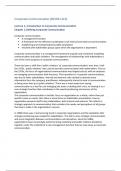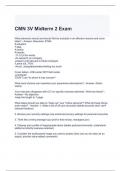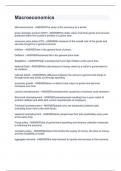Corporate Communication (825051-B-6)
Lecture 1, Introduction to Corporate Communication
Chapter 1, Defining Corporate Communication
Corporate communication:
▪ A management function
▪ A framework for the effective coordination of all internal and external communication
▪ Establishing and maintaining favourable reputations
▪ Involved with stakeholder groups upon which the organization is dependent
Corporate communication is a management framework to guide and coordinate marketing
communication and public relations. The management of relationships with stakeholders is
one of the main purposes of corporate communication.
There has been a shift from ‘public relations’ to ‘corporate communication’ over time. Until
the 1970s, ‘public relations’ was used to describe communication with stakeholders. Prior to
the 1970s, the focus of organizational communication was largely tactical, with an emphasis
on managing communication with the press. This transitions to ’corporate communications,
was due to other stakeholders, internal and external, who started to demand more
information form the company, practitioners subsequently started to look at communication
as being more than just ‘public relations’. There was a move away from seeing
communication as a tool for just managing the news or dealing with crisis, to viewing it as a
core strategic function that contributes to the overall positioning and success of the
organization.
This corporate communication is holistic: focus on organization as a whole, rather than just
specific issues or events. Also there is more focus on stakeholder presentation, how an
organization presents itself to key stakeholders, both internal and external. This reflects a
strategic approach to communication that considers the needs and perceptions of all groups
that have a stake in the organization’s success.
In 1980s there was a restructuring trend in corporate organizations and the realization that
strategic positioning was needed for stakeholders. This led to more strategic communication
and more integration between communications sub-disciplines. Since the 1980s,
organizations have increasingly started to bring marketing and public relations disciplines
together under the umbrella of a new management function that we now know as corporate
communication.
,Models for the relationship between marketing and public relations. Outlines the different
models that Kotler and Mindak described to characterize the relationship between marketing
and public relations. Models (c), (d) and (e) were models of integration of marketing and
public relations. Model (c) involves a view of marketing as the dominant function which
subsumes public relations. In model (e), the marketing and public relations have merged into
a single external communication function.
Model (a) was until the 1980s, where marketing and public relations were considered as
rather distinct in their objectives and activities, with each discipline going through its own
trajectory of professional development. Marketing deals with markets, whilst public relations
deals with all the publics (excluding customers and consumers) of an organization.
In the 1990s/2000s the focus was on integration and on the positioning in the mind of
stakeholders because of corporate branding, corporate identity and corporate reputation.
In 2010s, stakeholders became more active by voicing their expectations, self-organizing and
advocating. This was empowered by new media technologies and led to a shift towards
stakeholders sharing experiences, opinions and ideas about organizations. There were more
challenges and opportunities through word-of-mouth and peer-to-peer influence.
21st century corporate communications: an instrument of management by means of which
all consciously used forms of internal and external communication are harmonized as
effectively and efficiently as possible, with the overall objective of creating a favourable basis
for relationships with groups upon which the company is dependent.
,Corporate Communication is so complex because of a wide geographical range, a wide range
of services and products, various divisions and a hard to establish consensus within the
organisation.
Mission: Overriding purpose in line with the values and expectations of stakeholders.
Vision: Desired future state: the aspiration of the organization.
Corporate Objectives: Statement of overall aims in line with the overall purpose.
Strategies: The ways or means in which the corporate objectives are to be achieved and put
into effect.
Corporate Identity: The profile and values communicated by an organization.
Corporate Image: The immediate set of associations of an individual in response to one or
more signals or messages from or about a particular organization at a single point in time.
Corporate Reputation: An individual’s collective representation of past images of an
organization (induced through either communication or past experiences) established over
time.
Negative effects of a scandal can be countered by a communication strategy.
The scandal could have been prevented by communication management.
Scandals can be difficult because the economic power is immense, huge companies can pay
the best lawyers. But also the economic power for the national economy. That’s also why it
can be difficult to put the company responsible.
News talk about social consequences.
Case: The Voice of Holland
Lots of power and money involved because of popularity
Importance difference is between actors and stakeholders.
Who’s actions is leading to the crisis, who Is responsible? Who could have taken action and
preventing the case from happening?
Stakeholders are not directly responsible for the scandal
Who is concerned by the scandal?
Actors
Singers
Stakeholders
, What needed/needs to be done?
Bring out a statement
Investigations
Apologies
What has been done?
John de Mol was interviewed
Show was not broadcasted anymore
How can the negative effects be countered
Communication strategy
How could it have been prevented?
(Communication) management
Chapter 2, Corporate Communication in Contemporary Organizations
The development of an integrated effort to communicate with stakeholders led to the
realization of managers in most corporate organizations that the most effective way of
organizing communication consists in ‘integrating’ most, if not all, of an organization’s
communication disciplines and related activities such as media relations, issues
management, advertising and direct marketing.
‘Marketing public relations’ (MPR) use public relations techniques but are directly or
indirectly focused on the marketing of a company’s products and services. While ‘corporate
public relations’ (CPR) involve communication with investors, communities, employees, the
media and government.
The difference between corporate advertising and mass media advertising is that corporate
advertising deals with the ‘corporate’ image of the company to create or maintain a
favourable image of the company and its management, while mass media advertising is
focused on the company’s products or services to increase awareness or sales.
There are a number of ways in which marketing and public relations activities can
complement one another. A company’s image can positively reflect on its product brands,
thereby increasing the awareness of the product brand as well as enhancing consumers’
favourable impression of the brand.
Also, the guardian role of public relations as a ‘watchdog’ or ‘corrective’ for marketing in
bringing other viewpoints and the expectations of other stakeholders besides customers to
bear on strategic decision-making.
Lecture 1, Introduction to Corporate Communication
Chapter 1, Defining Corporate Communication
Corporate communication:
▪ A management function
▪ A framework for the effective coordination of all internal and external communication
▪ Establishing and maintaining favourable reputations
▪ Involved with stakeholder groups upon which the organization is dependent
Corporate communication is a management framework to guide and coordinate marketing
communication and public relations. The management of relationships with stakeholders is
one of the main purposes of corporate communication.
There has been a shift from ‘public relations’ to ‘corporate communication’ over time. Until
the 1970s, ‘public relations’ was used to describe communication with stakeholders. Prior to
the 1970s, the focus of organizational communication was largely tactical, with an emphasis
on managing communication with the press. This transitions to ’corporate communications,
was due to other stakeholders, internal and external, who started to demand more
information form the company, practitioners subsequently started to look at communication
as being more than just ‘public relations’. There was a move away from seeing
communication as a tool for just managing the news or dealing with crisis, to viewing it as a
core strategic function that contributes to the overall positioning and success of the
organization.
This corporate communication is holistic: focus on organization as a whole, rather than just
specific issues or events. Also there is more focus on stakeholder presentation, how an
organization presents itself to key stakeholders, both internal and external. This reflects a
strategic approach to communication that considers the needs and perceptions of all groups
that have a stake in the organization’s success.
In 1980s there was a restructuring trend in corporate organizations and the realization that
strategic positioning was needed for stakeholders. This led to more strategic communication
and more integration between communications sub-disciplines. Since the 1980s,
organizations have increasingly started to bring marketing and public relations disciplines
together under the umbrella of a new management function that we now know as corporate
communication.
,Models for the relationship between marketing and public relations. Outlines the different
models that Kotler and Mindak described to characterize the relationship between marketing
and public relations. Models (c), (d) and (e) were models of integration of marketing and
public relations. Model (c) involves a view of marketing as the dominant function which
subsumes public relations. In model (e), the marketing and public relations have merged into
a single external communication function.
Model (a) was until the 1980s, where marketing and public relations were considered as
rather distinct in their objectives and activities, with each discipline going through its own
trajectory of professional development. Marketing deals with markets, whilst public relations
deals with all the publics (excluding customers and consumers) of an organization.
In the 1990s/2000s the focus was on integration and on the positioning in the mind of
stakeholders because of corporate branding, corporate identity and corporate reputation.
In 2010s, stakeholders became more active by voicing their expectations, self-organizing and
advocating. This was empowered by new media technologies and led to a shift towards
stakeholders sharing experiences, opinions and ideas about organizations. There were more
challenges and opportunities through word-of-mouth and peer-to-peer influence.
21st century corporate communications: an instrument of management by means of which
all consciously used forms of internal and external communication are harmonized as
effectively and efficiently as possible, with the overall objective of creating a favourable basis
for relationships with groups upon which the company is dependent.
,Corporate Communication is so complex because of a wide geographical range, a wide range
of services and products, various divisions and a hard to establish consensus within the
organisation.
Mission: Overriding purpose in line with the values and expectations of stakeholders.
Vision: Desired future state: the aspiration of the organization.
Corporate Objectives: Statement of overall aims in line with the overall purpose.
Strategies: The ways or means in which the corporate objectives are to be achieved and put
into effect.
Corporate Identity: The profile and values communicated by an organization.
Corporate Image: The immediate set of associations of an individual in response to one or
more signals or messages from or about a particular organization at a single point in time.
Corporate Reputation: An individual’s collective representation of past images of an
organization (induced through either communication or past experiences) established over
time.
Negative effects of a scandal can be countered by a communication strategy.
The scandal could have been prevented by communication management.
Scandals can be difficult because the economic power is immense, huge companies can pay
the best lawyers. But also the economic power for the national economy. That’s also why it
can be difficult to put the company responsible.
News talk about social consequences.
Case: The Voice of Holland
Lots of power and money involved because of popularity
Importance difference is between actors and stakeholders.
Who’s actions is leading to the crisis, who Is responsible? Who could have taken action and
preventing the case from happening?
Stakeholders are not directly responsible for the scandal
Who is concerned by the scandal?
Actors
Singers
Stakeholders
, What needed/needs to be done?
Bring out a statement
Investigations
Apologies
What has been done?
John de Mol was interviewed
Show was not broadcasted anymore
How can the negative effects be countered
Communication strategy
How could it have been prevented?
(Communication) management
Chapter 2, Corporate Communication in Contemporary Organizations
The development of an integrated effort to communicate with stakeholders led to the
realization of managers in most corporate organizations that the most effective way of
organizing communication consists in ‘integrating’ most, if not all, of an organization’s
communication disciplines and related activities such as media relations, issues
management, advertising and direct marketing.
‘Marketing public relations’ (MPR) use public relations techniques but are directly or
indirectly focused on the marketing of a company’s products and services. While ‘corporate
public relations’ (CPR) involve communication with investors, communities, employees, the
media and government.
The difference between corporate advertising and mass media advertising is that corporate
advertising deals with the ‘corporate’ image of the company to create or maintain a
favourable image of the company and its management, while mass media advertising is
focused on the company’s products or services to increase awareness or sales.
There are a number of ways in which marketing and public relations activities can
complement one another. A company’s image can positively reflect on its product brands,
thereby increasing the awareness of the product brand as well as enhancing consumers’
favourable impression of the brand.
Also, the guardian role of public relations as a ‘watchdog’ or ‘corrective’ for marketing in
bringing other viewpoints and the expectations of other stakeholders besides customers to
bear on strategic decision-making.






